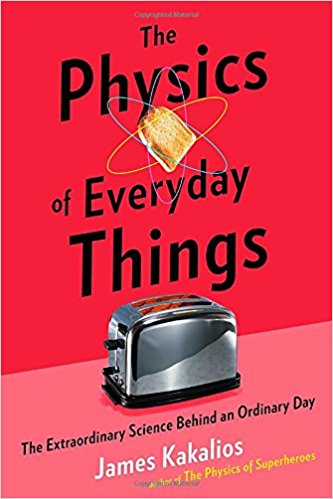
The Physics of Everyday Things: The Extraordinary Science Behind an Ordinary Day explains how the devices we take for granted–toasters, hairdryers, microwave ovens, TV remotes, etc.–work. James Kakalios takes us through a hypothetical day from morning to night and shows how the devices we use all the time use physics to operate. Now I understand how a laser pointer works (it’s more complicated than you think!). And Kakalios differentiates between LED, LCD, and OLED HDTVs. You’ll be astonished at the principles that keep our tech world operating. Kakalios writes in a clear style with plenty of examples. GRADE: B
TABLE OF CONTENTS:
1. Begin Your Day 1
2. You Drive into the City 29
3. You Go to the Doctor 57
4. You Go to the Airport 87
5. You Take a Flight 115
6. You Give a Business Presentation 141
7. You Go to a Hotel 177
Acknowledgemetns 207
Notes 211
Figure Captions 233
Index 237
I wish he could fix my computer issues.
Jeff, I tried to use AOL to fix my DELL computer, but their “Fix-It” program didn’t improve anything. So, a new computer has been ordered.
Jeff, a new computer is coming my way. Living with just an iPad is a pain. Hope your computer woes get resolved soon.
I had to uninstall and reinstall, but for the moment, all is well. Overall, I’m satisfied that we didn’t buy a new desktop. After this one goes we might stick to laptops and tablets (which Jackie uses most of the time), and the phones of course. As my cousin said last week about her phone after she dropped it in the toilet and had to replace it, “Our whole life is on it!”
Jeff, Patrick and Katie are firmly in the APPLE world so I will join them with this new desktop computer.
George, I hated science (physics-chemistry-biology) in school even as people would keep telling me how physics shaped our lives. I know it does. I just don’t want to know how!
Prashant, just think of technology as Magic!
This does sound helpful, but I’m so not a science person. I did badly in math and science in school, compared to english and history
Maggie, Kakalious clearly explains how devices work and he provides helpful diagrams and illustrations.
That might be a good book for “un-scientific people”!
As a mathematician and scientist, compter freak and builder of electronics I normally have no problems – but you never know …
And if you have no idea how something might work …
I still remember when as a pupil I built electronic “systems” from standard components – my best accomplishment was an AM transmitter (of very limited power of course) that I coupled to my old fashioned tape recorder or the radio that received rock music on American Forces Radio so I could listen to it on a small transistor AM radio while working for my parents in the garden.
Since then however I’ve just become a “user” of electronics like you all – it’s become much cheaper to just buy something (not the most expensive system!) and throw it away after a few years …
Technology develops so fast nowadays…
Having followed it for almost 60 years now (including the ideas in Science Fiction) I don’t dare a forecast how the world of technology will look in say another 30 years!
Things like microwaves, Lasers, LEDs, the whole IT have been so fantastic in their development – and young people of course take them for granted …
And I still remember the first coulou tv my parents bought – it cost a month’s wage!
Wolf, I’m always interested in learning how things work. However, I lack the “Fix-It” gene to do anything practical with the knowledge.
I don’t care HOW they work, only THAT they work!
Bob, sadly, many things in our house have stopped working. My computer, for one. We also had a leaky faucet that needed replacement. And my Water-Pik died and I had to buy a new one. It’s always something.
Yes, all things stop working after a certain time – whether mechanical, electronic or biological …
Planned obsolescence was a big word once, now I think it’s mainly cost as a reason and with technological advances it’s often sensible to throw things away (or better recycle their materials …).
Wish this held more interest for me. Maybe we could fix something then.
Patti, we just have a crew of “Fix-It” people since neither Diane nor I are handy.